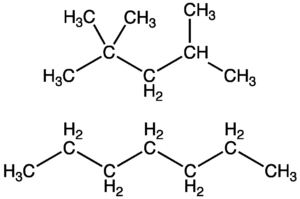Saturated hydrocarbon consists of carbon atoms bonded with each other and possesses a single bond. Now, let us list some examples of saturated hydrocarbon.
- Methane
- Ethane
- Propane
- Butane
- Hexane
- Cyclopropane
- Octane
- Cyclohexane
- Isooctane
Saturated hydrocarbon has only a single bond; no multiple bonds exist. The vacancy in valance electrons of carbon is filled by hydrogen. Thus, saturated hydrocarbon consists of more hydrogen atoms than unsaturated hydrocarbons. In this post, we will provide a detail explanation of saturated hydrocarbons.
Methane
Methane (CH4) is the simplest saturated hydrocarbon, lighter than air. It readily burns in the air forming carbon dioxide and water vapor. It is slightly soluble in water. Methane is the main component of paraffin. Methane is largely used in fertilizer industries and in the production of explosives.
Ethane
Ethane, the chemical formula is C2H6, is a colorless gas having 2 carbon atoms bonded with 4 hydrogen atoms. It is soluble in water. Ethane is the most important gaseous fuel as it is easily ignited. The vapor of ethane is heavier than air. It is most commonly used as a refrigerant.
Propane
Propane is non-toxic, colorless, odorless gas consisting of 3 carbon and 8 hydrogen atoms (C3H8) bonded covalently with each other. Propane is commonly used as domestic fuel and is a popular choice for barbeque and portable stoves. Propane can be liquefied at normal vapor pressure at -42°C and solidified at -187.7°C.
Butane
Butane consists of 4 carbon atoms bonded with 10 hydrogen atoms (C4H10). It is a colorless and highly flammable gas. Butane exists as a gas at room temperature and atmospheric pressure. Butane is a raw synthetic rubber material used as fuel for lighter. Butane is less soluble in water.
Hexane
Hexane (C6H14) is a straight-chain saturated hydrocarbon obtained from crude refinery oil. It is a non-polar molecule with weak intermolecular interaction. Hexane is mostly an organic solvent as it is insoluble in water.
Cyclopropane
Cyclopropane is composed of three carbon atoms forming a ring structure. Generally, it consists of 3 methylene groups (-CH2), so its molecular formula is C3H6 and and also called as Trimethylene. It is most commonly used as a general anesthetic agent. Cyclopropane mainly has a theoretical interest, but its derivatives have the most biological significance.
Octane
Octane is a saturated liquid hydrocarbon having 8 carbon atoms covalently bonded with 18 hydrogen atoms. Its condensed structural formula is given by CH3(CH2)6CH3. Octane is highly flammable; hence, it is used as a component of gasoline and an important agent of petroleum products.

Cyclohexane
Cyclohexane is a hydrocarbon comprising a ring of 6 carbon atoms with molecular formula C6H12. It is a colorless liquid with an odor similar to detergents. Cyclohexane is a non-polar and volatile compound. It has its main industrial application as a raw material in the production of nylon.
Isooctane
Isooctane, also called 2,2,4-Trimethylpentane, is a saturated hydrocarbon with the chemical formula (CH3)3CCH2CH(CH3)2. It is a colorless liquid that is an important component of gasoline. The boiling point of isooctane is 99.30°C.
Types of saturated hydrocarbon
The word saturated in terms of organic compound implies that all atoms are linked together by a single bond. Let us focus on types of saturated hydrocarbon.
Based on the structural arrangement of carbon atoms, saturated hydrocarbon is classified into two types:
- Alkanes – In this type, all carbon atoms are liked either as a linear arrangement or as a branch. Some physical properties, such as the melting and boiling point of alkanes, depends on the length of the alkane chain. The longer the chain melting and boiling point will be higher.
- Cycloalkanes –in this type, carbon atoms are arranged a ring shape. The ring can extend into branches forming a side chain. The physical properties of cycloalkane are similar to an alkane, but the melting and boiling point is quite higher.
Properties of saturated hydrocarbon
Saturated hydrocarbons have a wide range of industrial applications due to their versatile properties. Let us provide a list of the properties of saturated hydrocarbons.
- Saturated hydrocarbon exists in linear, branched and ring-like structures.
- All the carbon atoms present in the saturated hydrocarbon are sp3 hybridized.
- Saturated hydrocarbons do not contain any other functional group, i.e., it consists of only carbon and hydrogen.
- Saturated hydrocarbons are rich in hydrogen.
- Saturated hydrocarbons are non-polar and most are insoluble in water.
- The density of saturated hydrocarbon is less than that of water.
- The melting and boiling point of the saturated hydrocarbon depends on the chain’s length or the ring’s size.
- Saturated hydrocarbons are chemically less reactive compared to unsaturated hydrocarbons.
- The stability of saturated hydrocarbon is more than that of unsaturated hydrocarbon.
- Saturated hydrocarbons are flammable and mostly burn with a blue flame.
- Saturated hydrocarbon exhibits structural isomerism.
Conclusion
Let us end this post by stating that saturated hydrocarbon is the simplest hydrocarbon ever existing because it is made of only carbon and hydrogen. The saturated hydrocarbon consists of only a sigma bond which is harder to break; hence they are the most stable hydrocarbon.
Also Read:
- Liquid hydrocarbon examples
- Hydrocarbon examples
- Aromatic hydrocarbon examples 2
- Aliphatic hydrocarbon examples
- Carbon density
- Halogenated hydrocarbon examples
- Is carbon malleable
I am Keerthi K Murthy, I have completed post graduation in Physics, with the specialization in the field of solid state physics. I have always consider physics as a fundamental subject which is connected to our daily life. Being a science student I enjoy exploring new things in physics. As a writer my goal is to reach the readers with the simplified manner through my articles.